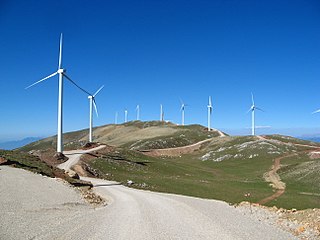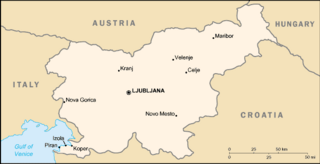This article relies largely or entirely on a single source .(January 2013) |
Wind power in Georgia consists of one wind farm, completed in 2013 with 20 MW of capacity. [1]
This article relies largely or entirely on a single source .(January 2013) |
Wind power in Georgia consists of one wind farm, completed in 2013 with 20 MW of capacity. [1]
Georgia had a total primary energy supply (TPES) of 4.793 Mtoe in 2016. Electricity consumption was 11.5 TWh in 2016. Electricity production was 11.6 TWh, of which 81% from hydroelectricity and 19% from natural gas. It is estimated that only 25% of Georgia's total energy is used.

Solar energy in Georgia is widely available, due to high average insolation.

Wind power in Asia is an important component in the Asian energy industry and one of the key sources of renewable energy in the region. As of April 2016, the installed capacity of wind power in Asia totalled 175,831 MW. Asia is the fastest growing region in terms of wind energy, having increased its installed capacity by 33,858 MW in 2005. China, with 145,362 MW of installed capacity, is the world's largest generator of electricity from wind energy. India is the second largest in Asia with an installed capacity of 25,088 MW. Other key countries include Japan, Taiwan, South Korea and the Philippines.
Colombia has 28.1 Megawatt installed capacity of renewable energy, consisting mainly of wind power. The country has significant wind and solar resources that remain largely unexploited. According to a study by the World Bank’s Energy Sector Management Assistance Program (ESMAP), exploitation of the country’s significant wind potential alone could cover more than the country’s current total energy needs.

Energy in Armenia describes energy and electricity production, import and consumption in Armenia.

Wind power in Greece was due to expand by 352% by 2010 to meet the European target of 20% coverage of energy needs from renewable sources. Previously, there were 1,028 wind turbines installed throughout Greece and the number was set to reach 2,587 wind turbines before the end of 2010.

As of 2016, Wind power in Vermont consists of 119 megawatts (MW) of operational wind farms, responsible for 15.4% of in-state electricity generation. Together these wind projects would meet the electrical needs of approximately 56,000 average Vermont households.
The North Sea Offshore Grid, officially the North Seas Countries Offshore Grid Initiative (NSCOGI), is a collaboration between EU member-states and Norway to create an integrated offshore energy grid which links wind farms and other renewable energy sources across the northern seas of Europe. It is one of several proposed European super grid schemes.

The electricity sector in Belgium describes electricity in Belgium. Production by power source in 2009 was 53% nuclear, 40% fossil electricity and 7% renewable electricity. 2% of production was exported in 2009. In 2008 import was 11%. Belgium is highly nuclear dependent country where the share of renewable electricity has been low. The share of renewable electricity was about 2% in 2005. Plan for 2020 is wind 10.5 TWh (9.5%), biomass 11 TWh and PV 1 TWh.

In 2009, Poland was world's 9th largest hard coal producer. The country is also the second largest coal consumer in Europe behind Germany.
Renewable energy in Pakistan is a relatively underdeveloped sector; however, in recent years, there has been some interest by environmentalist groups and from the authorities to explore renewable energy resources for energy production in light of the energy crises and power shortages affecting the country. Most of Pakistan's renewable energy comes from hydroelectricity.
Energy in Slovakia describes energy and electricity production, consumption and import in the Slovak Republic. Energy policy of Slovakia will describe the energy policy in the politics of Slovakia more in detail. Electricity sector in Slovakia is the main article of electricity in Slovakia.

Total primary energy supply (TPES) in Slovenia was 6.67 Mtoe in 2014. In the same year, electricity consumption was 13.87 TWh.

Solar power in Mississippi is an underutilized generation method; however, large changes are expected by 2016. The state reached only 1 MW of grid-connected solar electricity in 2013. Rooftop photovoltaics can provide 31.2% of all electricity used in Mississippi from 11,700 MW of solar panels.

Wind power in Kenya contributes only a small amount of the country's electrical power. However, its share in energy production is increasing. Kenya aims to generate 2,036 MW of wind power, or 9% of the country's total capacity, by 2030.
The renewable energy sector in Kenya is among the most active in Africa. In Kenya, investment grew from virtually zero in 2009 to US$1.3 billion in 2010 across technologies such as wind, geothermal, small-scale hydro and biofuels. This is not saying that Kenya was never active in the renewable energy sector. Kenya is Africa's first geothermal power producer and leads Africa in the number of solar power systems installed per capita. It is still the largest producer of geothermal power in Africa today at 200 MW with only one other African country producing geothermal power, Ethiopia. Connectivity to the national grid in Kenya currently stands at 28%. In 2011, Kenya was also the first country in Africa to open a carbon exchange.
Renewable energy in Greece accounted for 8% of the country's total energy consumption in 2008. 12% of Greece's electricity comes from Hydroelectric power plants. In 2015, renewable energy counted for more than 20% of the energy produced in Greece; this excludes energy produced by hydroelectric means, which accounts for more than 8%
Although Turkey has plenty of renewable resources only hydropower has been much developed, averaging about a fifth of electricity supply. However because this is vulnerable to droughts less electricity than usual is from hydro in those recent years, compared to around a third in a wet year. The country is aiming for half of electricity to be from renewables by 2023 but Turkey has invested less in solar and wind power than similar Mediterranean countries. Turkey needs a renewable energy plan beyond 2023 which includes transport, industry, heating and cooling as well as electricity generation. Turkey is a net exporter of wind power equipment but a net importer of solar power equipment.
| This article about renewable energy is a stub. You can help Wikipedia by expanding it. |
| This Georgia-related article is a stub. You can help Wikipedia by expanding it. |